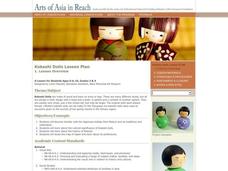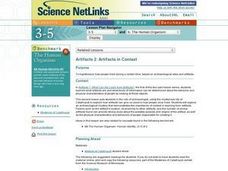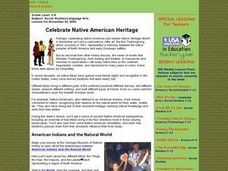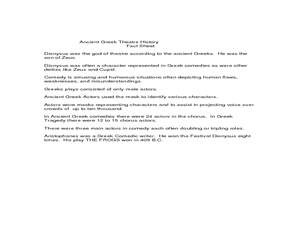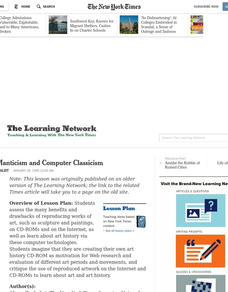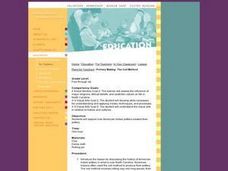Curated OER
Understanding Cladistics
Students explore cladistics and create a cladogram of their own. They are shown how the scientist at the American Museum of Natural History use a method called cladistics to group animals. Students are asked how the animals (lion,...
Curated OER
Kokeshi Dolls
Students study the Japanese holiday Hina Matsuri and its traditions and celebration. They explore the history, location and cultural significance of Kokeshi dolls.
Curated OER
Breaking the Chains: Rising Out of Circumstances
Study history through photographs. In this visual arts and history lesson, students learn to analyze photographs to discover details about life during the Civil War era. Students write journal entries as if they are the African-American...
Curated OER
"When They Came for Me, There Was No One Left to Speak Up" - Exploring Personal and Collective Responsibility in WWII
Students examine the underlying meaning of the phrase spoken by Pastor Martin Niemoller in 1945, "When they came for me, there was no one left to speak up." In this World History lesson, students share in a class discussion on civic and...
Curated OER
Artifacts 2: Artifacts in Context
Students explore world history by completing artifact worksheets. In this archaeology instructional activity, students identify the importance of finding clues when researching historical information by utilizing artifacts. Students...
Curated OER
Technically Speaking
Young scholars research how various forms of technology have changed during different time periods and the ways in which technology impacts society. They propose designs for galleries within a technology museum.
Curated OER
Telling Time Timeline
Use the Internet and library resources to compose a telling time timeline -- a visual history of time. Students will develop research skills and gain perspective about telling time by discovering the history of clocks and time.
Curated OER
Talk to the Hand
Students explore the significance of various body parts in artistic and social expression. They research a body part and create a museum installation depicting the artistic and social significance of the body part throughout history.
Curated OER
Celebrate Native American Heritage
Students examine Native American heritage. They explore a museum of Native American culture and explore their food, dress, and customs. They also explore the Native Americans role in the first Thanksgiving.
Curated OER
Look Before You Think: How To Appreciate a Painting
Learners develop an elementary understanding of the history of art. They study the basic elements of a painting including perspective, composition, color, light and symbolism. They look at each selected painting and analyze it, moving...
Curated OER
Language Arts: Conversing with an Object
Students sharpen their creative writing skills by writing dialogues with unfamiliar objects while visiting local museums. They select an object in the museum, such as a painting, and create conversations between the people or animals...
Curated OER
Dancing with Dionysus
Sixth graders research Ancient Greek culture by acting in a play for the festival of Dionysus. In this Greek culture lesson, 6th graders study an ancient Greek map and the Sarcophagus Dionysus from the Walters Art Museum website....
Curated OER
1,000 Cranes
Students improve motor skills through careful folding, a discipline necessary in the practice of origami. They develop multicultural awareness by exploring Japanese history.
Curated OER
Philately
Students examine the history of stamps, the working of the postal system, and how stamps are used in our lives. They create a collage using stamps. They create a new stamp honoring a special event, person, etc.
Curated OER
Heroes and Heroines: King David, Julius Caesar, Cleopatra and Napoleon
Students identify and examine four heroes from history and imaginative literature. They discuss the characteristics of a hero and share perceptions of what makes a hero. By comparing and analyzing a few historical and literary figures,...
Curated OER
Interpreting Mythology Through Dance
Students use abstract movement to tell the story of Re's journey. In this ancient Egypt lesson, students choreograph locomotor and non-locomotor movements to describe ancient Egyptian journeys to the afterlife as described in Egyptian...
Curated OER
CD-ROManticism and Computer Classicism
Students assess the many benefits and drawbacks of reproducing works of art, such as sculpture and paintings, on CD-ROMs and on the Internet, as well as explore art history via these computer technologies.
Curated OER
Rhythm Nation
Learners read a New York Times article to help them develop an understanding of the history, development, and social influence of various types of world music through the creation of music museum exhibits.
Curated OER
Trouble in the Fields: Mexican Migrant Workers
Students become curators and museum reviewers for an online gallery using a selected group of primary sources on Mexican migrant workers. They share and reflect on their own and each other's ideas though participation in an on-line...
Curated OER
Pottery Making: The Coil Method
Students discuss the history of Native American pottery in North Carolina. They explore the coil method of making pottery and make their own creations implementing the coil method. They can allow the pots to dry or have them kiln-fired.
Curated OER
Mosaic America: Paths To The Present
Seventh graders study the ideologies of life, values, love, peace and struggle of African Americans, Latinos and Native Americans as citizens of the United States. Authors and artists are used as tools to open the eyes of the students...
Curated OER
The City of New Haven
Young scholars examine the geography, politics and history of their local town of New Haven, Connecticut. Using the internet, they explore the neighbors of New Haven and write directions from their house to school. In groups, they...
Curated OER
Everyday Objects
Students reflect in their journals about an everyday object they take for granted. After reading an article, they examine what a cook's tools can reveal about their life. In groups, they research everyday objects and write a museum...
Curated OER
The Forgotten Cities
Students recognize and identify gaps in historical and archaeological evidence and how that evidence is interpreted. They explore the history of the Indus cities and identify what was left behind that survived for archaeologists to find...



